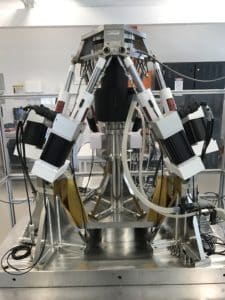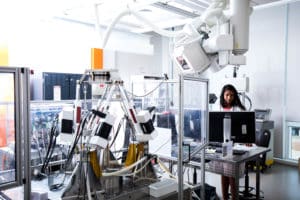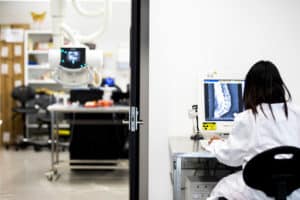High res photos available below.
Video of Dhara and the bending robot available here.
Some slipped disc injuries might be caused by movements other than the commonly blamed bending and twisting, according to new research by South Australian engineers.
It’s a finding that will lead to a better understanding of the motions that put people at greatest risk of a slipped disc and help develop more robust guidelines for safe lifting.
“It’s always been assumed that bending and twisting is the mechanism for a slipped disc,” says Dhara Amin, a PhD candidate at the Flinders University Medical Device Research Institute.
“We wanted to test this theory in the lab using the more advanced technology we now have access to.”
Slipped discs—technically known as lumbar disc herniations—are a common source of sciatica (radiating pain down the legs) in the young and middle-aged.
The ‘discs’ are made of an elastic casing around a jelly-like material (called the nucleus), which helps absorb shock and keep our spine stable by slotting between the vertebrae.
A slipped disc is like squeezing a jam doughnut: the jam oozes out. If you pressurise and bend the disc, the nucleus bulges out of its casing, impinging the nerves coming out of the spinal cord and causing radiating pain down the legs and potentially back pain.
Dhara’s team used a special robot called the Hexapod, which simulated a year’s worth of ‘lifting’ a 20kg box, with bending and twisting movements on sections of cadaveric human spine.
“The Hexapod Robot at Flinders University is unique because we can mimic human movements that previously weren’t possible using the standard mechanical testing devices,” Dhara says.
They tracked the disc failure patterns and found that only half of the spines failed via slipped discs, while the others failed via bone injuries.
“The result was interesting—we expected all of the specimens to fail by slipped discs,” Dhara says.
“This leads us to believe there are other motions that can cause a slipped disc, which may be worse than just bending and twisting.”
Further research on other combinations of motions will help us better understand what causes a slipped disc, Dhara says.
Professor Brian Freeman, Head of Spinal Surgery at the Royal Adelaide Hospital, worked with Dhara on this project.
“The prevalence of lumbar disc herniation is estimated at three-to-five per cent. Lumbar disc herniation often presents with acute low back pain, followed by severe leg pain. These symptoms can persist for some time, resulting in work absence with significant cost to the economy,” Brian says.
“Research like this is crucial if we are to reduce the incidence of disc herniation. It’s important for those involved in manual handling tasks to be educated in safe lifting practice.”
Dhara was the South Australian winner of Fresh Science, a national competition run by Science in Public, which helps early-career researchers find and share their stories of discovery.
Fresh Science in Adelaide was supported by the South Australian Museum, the University of South Australia, Flinders University and the University of Adelaide.

Credit: Flinders University



